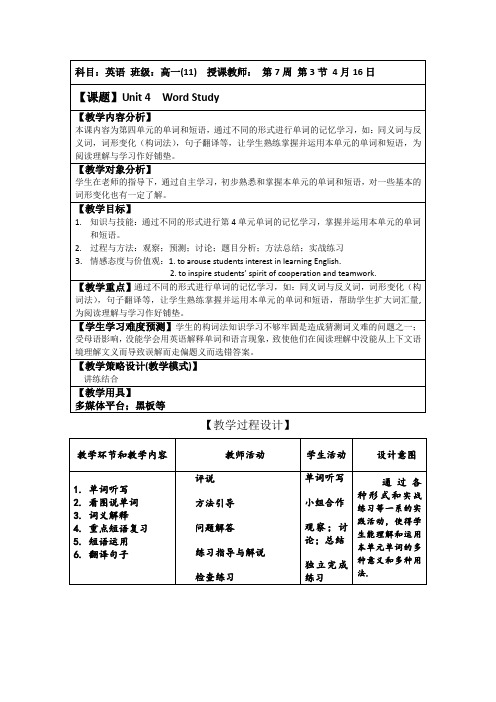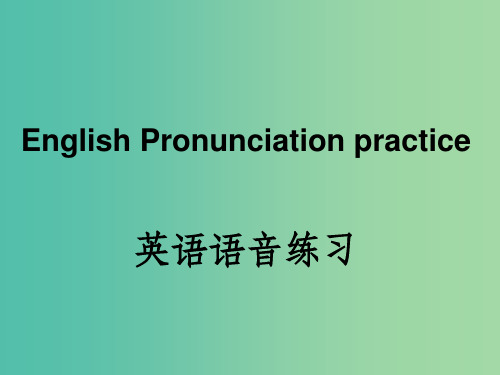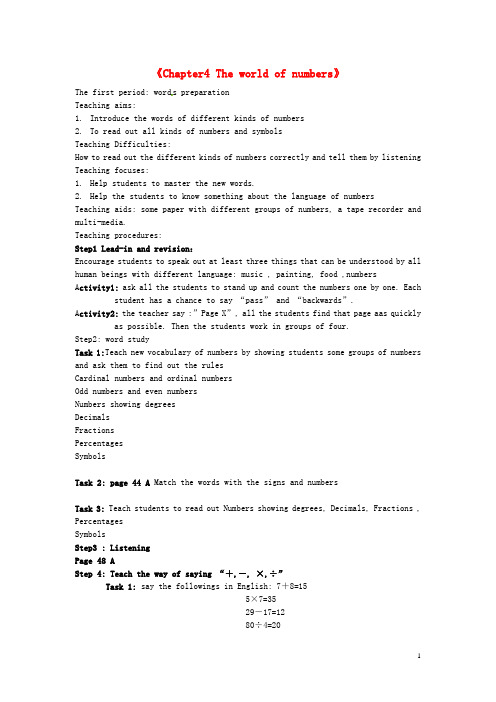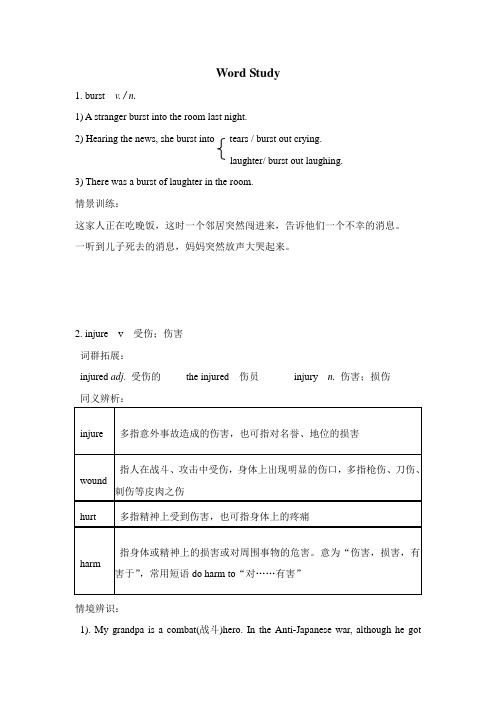七上Unit 4 Word study
- 格式:ppt
- 大小:10.50 MB
- 文档页数:35




《Chapter4 The world of numbers》The first period: word s preparationTeaching aims:1.Introduce the words of different kinds of numbers2.To read out all kinds of numbers and symbolsTeaching Difficulties:How to read out the different kinds of numbers correctly and tell them by listening Teaching focuses:1.Help students to master the new words.2.Help the students to know something about the language of numbersTeaching aids: some paper with different groups of numbers, a tape recorder and multi-media.Teaching procedures:Step1 Lead-in and revision:Encourage students to speak out at least three things that can be understood by all human beings with different language: music , painting, food ,numbersA ctivity1: ask all the students to stand up and count the numbers one by one. Eachstudent has a chance to say “pass” and “backwards”.A ctivity2: the teacher say :”Page X”, all the students find that page aas quicklyas possible. Then the students work in groups of four.Step2: word studyTask 1:Teach new vocabulary of numbers by showing students some groups of numbers and ask them to find out the rulesCardinal numbers and ordinal numbersOdd numbers and even numbersNumbers showing degreesDecimalsFractionsPercentagesSymbolsTask 2: page 44 A Match the words with the signs and numbersTask 3: Teach students to read out Numbers showing degrees, Decimals, Fractions , PercentagesSymbolsStep3 : ListeningPage 48 AStep 4: Teach the way of saying “+,-, ×,÷”Task 1: say the followings in English: 7+8=155×7=3529-17=1280÷4=20Task 2: choose any to pieces from the cards, ask the students to make the result 10 by using “+,-, ×,÷”. (the cards J, Q, K are “0”) HomeworkExercise book :vocabulary ABCThe second period: VocabularyTeaching aims:Master all the new words in this unit.Teaching difficulties:The spelling of new words.Teaching aids:The multimedia and the blackboardTeaching proceduresStep 1: write down “0” on the blackboard,talk about it and present: ancient numbers, consist of , Indian, develop, invent, invention...show pictures of an abacus and an electronic calculator and a computerTalk about them and present the new words:invent invention abacus calculator accurate ...Step 2: Ask the students to finish Part C1,PartC2PartC3.Part DPart EComplete each task individually first and then discuss in groups then in the class.Step3. Further study.Learn more expressions about dif ferent usage of numbers.1.房号: 1103 ---- Room 11032.班级、年级-- Class 6, Grade 9/Form Three3.时间: 6:50-- six fifty; ten to seven4.年、月、日: 1986/12/6--- December the sixth, nineteen eighty-six5.温度:36°C--thirty-six Celsius degree6.序数: 12th-- twelfth 14th——fourteenthStep4: More activitiesActivity1; work in groups of four, one student say some numbers from 1 to 1oo quickly, the others write them down as quickly as possible. Activity2; work in groups of four, one student say some numbers from 1 to 1oo quickly, the others circle them on a piece of paper which is full of differentnumbers as quickly as possible.Activity3; fill in the blanks with appropriate numbers.two,five,eight,eleven,fourteen,______ , twentytwo,four,seven,eleven,sixteen,______ , twenty-ninethree , four, seven, eleven, _______four , nine, ______ twenty-fiveHomework:Exercise book :vocabulary DThe third period: readingTeaching Aims:1.Learn about numbers from the old world to the present world2.Train the stu dents’ reading ability.Teaching Important Point:1.Improve the students’ reading ability.2.Develop the students’ creative, comprehensive and consolidating abilities. Teaching Difficult Point:1.How to improve the students’ reading ability.2. The use of some useful expressions about numbersTeaching Methods:Individual, pair or group work to make every student work in class.Teaching Aids:The multimedia and the blackboardTeaching Procedures:Step 1 Presentation1.Ask students how much they know about the world of numbers.2.Show some pictures of different kinds of calculating machines to the students to arouse their interest.Step 2 Look and thinkRead the title, its subtitle, the headings and the pictures. Then on the list below, tick the tings you think the article may tell you.Step 3 Reading1.Give the students some questions about the text.1.How many kinds of calculating machines are there in the text?2.What are they?3.Who first invented and developed the system 1 to 9 system?4.Was Zero invented first?5.Step 4. Find out the fact in Part D & E1.Li: Everyone knows it.May : Knows what?Li: The language of numbers.2.Li: ______________.3. Li: ______ ________4. Li:____________5. Li:____________6. Li:______________________.7. Li:____________8. Li:____________Step 5 Consolidation and homework:1.Read the whole article after the tape.2.Copy the new words in the article 4 times for each. And memorize them by heart.Step 6 homeworkExercise Book : ReadingThe fourth period: languageTeaching Aims:1. Learn about giving orders or instructions.2. Train the students’ language ability to use cardinal and ordinal numbersTeaching Important Points:1. Improve the s tudents’ language ability2. Enable the students to master the words and grammar3. Develop the students’ creative, comprehensive and consolidating abilities.Teaching difficult Points:1. How to improve the students’ language ability.2. How to use imperative sentencesTeaching Methods:1. Individual, pair or group work to make every student master the knowledge.Teaching Aids:The multimedia and the blackboard.Teaching Procedures:Step 1: Further study of the passage.Task 1: Work in pairs to find out the phrases from the passage.1.在古代 in ancient times2 以不同方式 in different ways3由…组成consist of4从…到… from …to5数字系统 system of numbers6计算机器 calculating machines7在算盘上 on the abacus8电子计算器 calculators9进行计算 do calculation10短时间内/迅速 in a flash11 能够 be able to do12 在你一生的时间里 in your whole life13下面的故事 the following story14解决问题 solve the problems15 够强大 powerful enoughStep 2:Explain some key sentences from the passage1.In ancient times, people wrote numbers in different ways.2.However they nearly all counted in tens.3.The system of numbers today consist of the number from 1 to 9and 0.4.Abacus are so fast and accurate that people still use it today.5. A computer can so a calculation in a flash.6.She has an amazing brain and can calculate like lightening.Step 3 Practice reading1.Ask the students to read the key sentences above after the teacher.2.Ask the students to read the whole passage after the tape and then together.Step 4 Language祈使句 : 是表示请求、命令、建议等句子,通常称为“无主句”。

Word Study1. burst v. / n.1) A stranger burst into the room last night.2) Hearing the news, she burst into tears / burst out crying.laughter/ burst out laughing.3) There was a burst of laughter in the room.情景训练:这家人正在吃晚饭,这时一个邻居突然闯进来,告诉他们一个不幸的消息。
一听到儿子死去的消息,妈妈突然放声大哭起来。
_____________________________________________________________________ _____________________________________________________________________ _____________________________________________________________________ 2. injure v 受伤;伤害词群拓展:injured adj. 受伤的the injured 伤员injury n. 伤害;损伤同义辨析:情境辨识:1). My grandpa is a combat(战斗)hero. In the Anti-Japanese war, although he got________ three times, he was never afraid and still fought bravely.2).She ________ his legs last week. You shouldn’t have laughed at her. You know,your words _________ her feelings.3).Jamie, stop playing computer games. After all, it will do _______ to both youreyes and study.4).More than 200,000 people were ________ in that earthquake.3. ruin n.废墟;毁灭vt.毁灭;使破产We saw the ruins of the church.Heavy smoking ruined his health.【归纳拓展】be in ruins成为废墟come into ruins 毁灭,成为废墟be the ruin of 成为……毁灭(堕落)的原因ruin oneself 自取灭亡ruin one's health/fame 毁坏某人的健康/名誉情境辨识:1)大火烧毁了这栋大楼,造成了很大的损失。

第一部分:概述1. 介绍文章的主题:人教版七年级上册英语第四单元2. 简要介绍第四单元的内容和学习目标第二部分:单元内容概述1. 介绍单元的主题:My Day2. 内容包括日常活动、时间表、动词短语等3. 学习目标包括掌握相关词汇、句型和能力第三部分:词汇和句型学习1. 列举本单元重点词汇和短语,例如:get up, have breakfast, go to school等2. 讲解相关句型和语法知识,例如:动词的一般现在时态、时间状语的使用等第四部分:听力和口语训练1. 介绍本单元的听力训练内容,例如:听取不同场景的日常活动、时间表等2. 讲解口语训练的重点,例如:模拟日常活动对话、描述自己的一天等第五部分:阅读和写作训练1. 介绍本单元的阅读材料,例如:描述不同人的日常活动、时间表等2. 强调写作训练的主要内容,例如:写一篇关于自己一天的日记、描述家人的一天等第六部分:语法和综合训练1. 概述本单元的语法重点,例如:一般现在时的肯定句、否定句、疑问句等2. 强调综合训练的重要性,例如:完成听说读写多种练习,加强能力的综合提升第七部分:小结和复习指导1. 总结本单元的重点内容和学习重点2. 提出学习方法和复习指导,例如:多听多说、多读多写,积极参与课堂练习和小组讨论等第八部分:结束语1. 强调学习英语的重要性和积极性2. 鼓励学生在学习中勤加练习,取得更好的进步和成绩以上是按照非Markdown格式的普通文本撰写的文章,希望对您有所帮助。
第三部分:词汇和句型学习本单元的主题是“My Day”,在这一部分中,学生们将学习关于日常生活的词汇和句型。
这些词汇和句型包括描述日常活动、表达时间的词汇以及一般现在时的句型等。
在学习过程中,学生们将掌握和运用这些词汇和句型,使他们能够更流利、准确地表达自己的日常生活。
词汇是语言的基础,因此我们将从以下方面展开学习:1. 日常活动词汇:通过学习动词短语如get up, do homework, have dinner等,学生们可以用英语描述自己的日常生活。
精选】人教版七年级上册英语Unit4第四单元优秀教案Unit 4 Where's My School Bag?n A (1a-1c)XXX:1.Key words: where。
table。
bed。
bookcase。
sofa。
chair。
on。
under2.Key phrases: on the sofa。
in your bag。
under your bed3.Key XXX:Where are my books?They are on the sofa.Where's my pencil box?It'XXX.Where's my computer game?It's under your bed.Focus of Learning:1.Correct use of special XXX "where"2.Describing the n of items using nal phrasesDifficulties in Learning:1.Correct use of special XXX "where"2.Describing the n of items using nal phrasesSelf-Study:1.Preview the new words on page 19 and memorize them。
Complete the following n from Chinese to English:Where: ________ 2.Table: ________ 3.Bed: ________ 4.Sofa: ________ 5.Chair: ________ 6.On: ________ 7.Under: ________2.Carefully preview 1a。
1b。
and 1c。